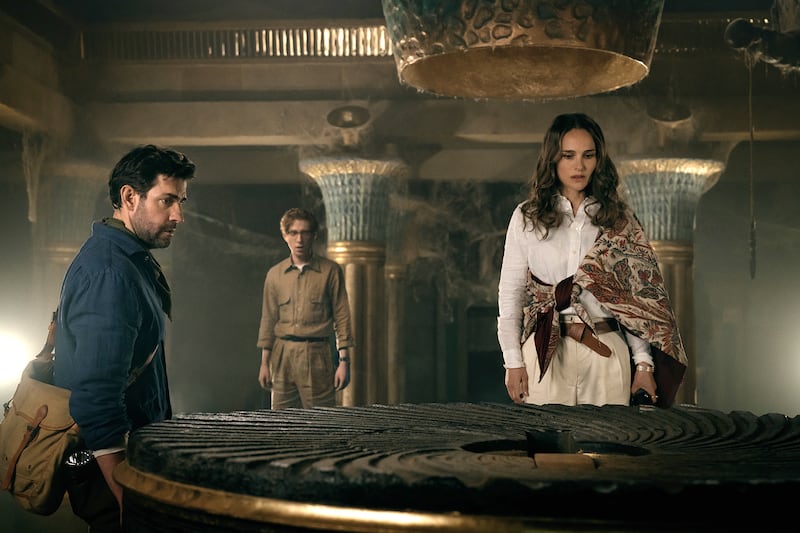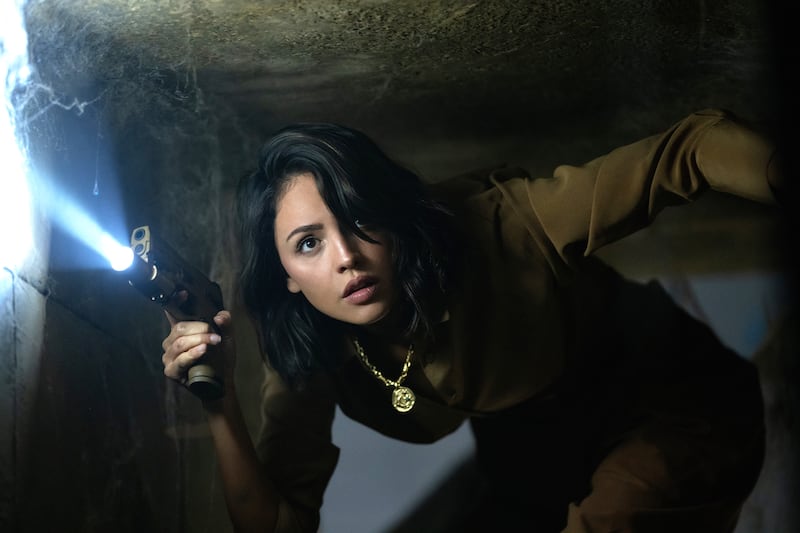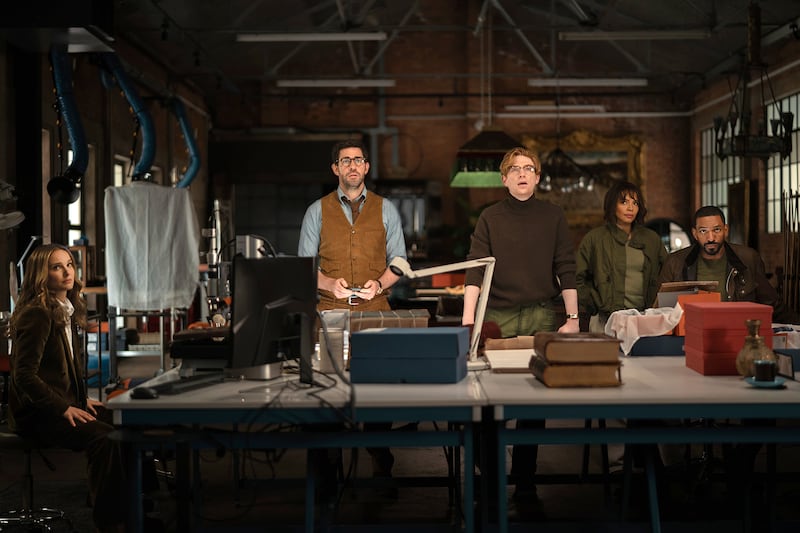As proven by everything from his breakthrough Lock, Stock and Two Smoking Barrels to his recent Operation Fortune: Ruse de Guerre and The Ministry of Ungentlemanly Warfare, Guy Ritchie loves stories about cocky wisea– rogues who assemble ragtag teams for heists, schemes and quests. That fixation continues with Fountain of Youth.
The director’s latest’s resemblance to his past efforts, however, pales in comparison to its similarity to the Indiana Jones franchise—a governing inspiration whose rollicking, sweeping spirit it tries, and fails, to channel. Refusing to take itself seriously enough, which makes its jauntiness come across as frivolity—and thus kills any engagement with its silliness—it’s merely a cheeky pantomime rather than an actual adventure in which one might get swept up.
Premiering on Apple TV+ on May 23, Fountain of Youth concerns a search for the mythic spring, whose promise of eternal life is comparable to that offered by the Holy Grail—the very legendary object Harrison Ford’s hero sought in Indiana Jones and the Last Crusade.

Ritchie’s film follows in the footsteps of Spielberg’s series from the get-go, picking up with Luke Purdue (John Krasinski) as he flees Bangkok gangsters who are mad that he’s stolen their boss’ priceless painting. This work of art is central to Luke’s mission to find the Fountain of Youth on behalf of billionaire Owen Carver (Domhnall Gleeson), who’s dying and thus seeks its immortality-granting power.
Apparently, figuring out the spout’s location involves six famous works of art (by Caravaggio, Rubens, Wildens, Velazquez, El Grego, and Rembrandt) that feature secret signatures in invisible ink that read “sex et unum,” or “six and one.” That clue supposedly leads to the path to the holy site—and it’s rumored that a group of Protectors are tasked with keeping its whereabouts secret.
Luke’s escape from Bangkok culminates with a run-in with one such Protector, Esme (Eiza González), and their scuffle is of a playful sexualized sort. Krasinski and González, however, don’t share any real chemistry so much as the film signals that their characters do—just as the globe-trotting proceedings are fleet and action-heavy and yet largely inert.

Luke makes it back to London with his painting and promptly visits his sister Charlotte (Natalie Portman), who works as a museum curator. He steals her collection’s Rembrandt, instigating a second rollicking chase sequence that puts Interpol agent Abbas (Arian Moayed) on his tail and entices Charlotte to join his hunt for the Holy Grail. Apparently, their dad was a renowned archeologist who taught them to love adventure, although Charlotte doesn’t like that her brother now uses that lesson to justify his criminal enterprises.
Charlotte spends most of Fountain of Youth flip-flopping between being a gung-ho participant in these escapades and complaining about Luke’s rule-breaking methods, turning her into a schizophrenic nag.

Whereas she’s inconsistently characterized, the rest of Luke’s squad, Murph (Laz Alonso) and Deb (Carmen Ejogo), are ciphers; James Vanderbilt’s script doesn’t imbue them with even one personality trait that would allow them to function as colorful support. Moreover, it can’t mask the fact that Gleeson’s wealthy benefactor is far shadier than he lets on, thereby undercutting the third-act bombshells. Because its every quip, feat, and twist feels like a second-rate act, the possibility of surprise winds up being nil.
There’s much blather throughout Fountain of Youth about Latin, artistic codes, and hidden chambers that, preposterously, haven’t been previously noticed, but Ritchie’s film lacks a sense of discovery or ingenuity. Its characters figure out each piece of their intricate Dan Brown-esque puzzle with amazing speed and ease, such that at a late juncture, Luke, faced with an enormous chamber he doesn’t know how to descend, solves his problem by simply bending down and turning a jeweled rock—a magical bit of intuitiveness that’s in line with the material’s fondness for shortcuts.
Luke also suffers puzzling dreams about former treasures and aged faces, and while they’re intended to enhance mystery about his past and present (and the hang-ups plaguing him), they’re too inscrutable to make an impression or to cast Luke in a three-dimensional light.

Ritchie delivers all the elements needed for a good Indiana Jones knock-off: car chases, shootouts, historical hotspots, celebrated masterworks, underwater and subterranean expeditions, and Luke stating things like, “There’s a seed of truth cloaked within every myth, metaphor or fable.” Yet his many scenes of intellectual investigation and daring exploration are cursory instead of involved, busy instead of breathtaking, and it’s not long before the film’s energy flags.
The director’s set pieces are well executed if anonymous and forgettable, and the tale’s recurring gags—Charlotte’s taste for champagne, Murph being left outside sites to keep watch—are half-formed and ineffective. Krasinski strives to exude brash, rascally charm and humor as Luke, but the role doesn’t quite suit him; as with everything else here, he comes across as working hard to channel an illustrious ancestor.
Fountain of Youth ultimately has Charlotte bring her 11-year-old son Thomas (Benjamin Chivers) on this odyssey, and wouldn’t you know it, the piano prodigy uses his musical gifts to deduce an ancient brainteaser.
The film is all cutesy details in service of an unoriginal endeavor, and its late passages reveal that it never had a good idea about its destination in the first place. Every climactic development is less believable than the last, and more than one hinges on outright magic. Worse, its resolution is so incoherent and unsatisfying that it feels as if the entire project has altogether given up, shrugging its shoulders and indulging in chaotic madness that doesn’t tell us anything about its protagonists or the Fountain of Youth and its capacity to bestow blessings or curses.
Emblematic of this misfire’s clumsiness, Stanley Tucci shows up for a fleeting moment as a Protector bigwig who imparts ominous orders and hands Esme a key that’ll come in handy during the big finale. Ritchie doesn’t botch any technical element of Fountain of Youth so much as he falls short of conjuring an atmosphere of wonder, danger, and swashbuckling excitement.
No matter his gifts for tales about motley crews, this sub-Spielbergian venture isn’t in his rough-and-tumble wheelhouse, the result being a clunky farce that never escapes its ancestors’ shadow—
The post Everyone Should Be Embarrassed About This Indiana Jones Knock-Off appeared first on The Daily Beast.




